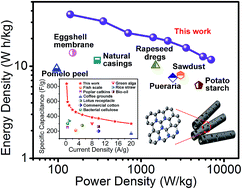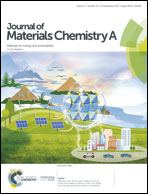A novel fabrication strategy for doped hierarchical porous biomass-derived carbon with high microporosity for ultrahigh-capacitance supercapacitors†
Abstract
Biomass derived carbons with a high surface area, an appropriate pore size distribution, and abundant heteroatoms are viewed as intriguing electrode materials for the assembly of high performance supercapacitors, while achieving both the pore structure and the heteroatom engineering simultaneously still remains a challenge. In the present work, we propose a facile and novel synthesis strategy with urea as a micromolecular dual-functional template to prepare an interconnected nitrogen-doped hierarchical porous carbon material with high microporosity (86.8%) and small mesopore size (2–4 nm) from Firmiana simplex fluff (FSF) as the biomass precursor. After Co2+ catalyzed graphitization and molten KOH treatment, the as-prepared carbon also showed a high surface area (2351 m2 g−1) and low internal resistance for charge transfer. The as-prepared carbonaceous electrode delivered a record high capacitance value of 836 F g−1 at a current density of 0.2 A g−1 in 2 M H2SO4. An assembled symmetric supercapacitor also achieved a record high aqueous energy density for biochar of 36.50 W h kg−1 at a power density of 140 W kg−1 in 2 M Li2SO4. This method provides new insight into the pore structure and defect engineering of carbon and also represents an effective approach to the fabrication of high-capacitance/energy density biochar electrodes.



 Please wait while we load your content...
Please wait while we load your content...